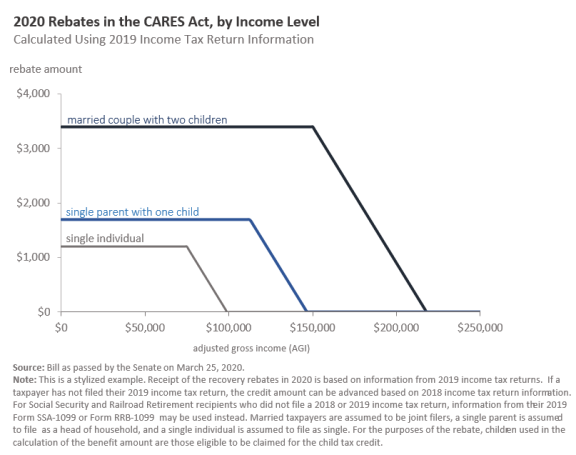
H.R. 748, which passed in the Senate on March 25, proposes direct payments intended to broadly stimulate the economy in response to concerns about an economic slowdown stemming from the COVID-19 pandemic. This Insight provides a brief overview of the proposed 2020 recovery rebates included in H.R. 748. These payments are virtually identical to those included in bill text circulated on March 22, 2020.
The proposed 2020 recovery rebates equal $1,200 per person ($2,400 for married taxpayers filing a joint tax return) and $500 per child. These amounts would phase down for higher-income taxpayers. These payments are structured as tax credits automatically advanced to households in 2020 if they filed a 2019 income tax return and would be received as a direct deposit or check by mail. If a 2019 return had not been filed, rebates would be advanced automatically based on 2018 return information. Social Security and Railroad Retirement recipients who did not file an income tax return would have the credit automatically advanced in 2020 based on information on their 2019 Social Security or Railroad Retirement Benefit Statement.
The proposed credit equals $1,200 per person ($2,400 for married joint filers) for eligible individuals. Generally, an eligible individual is any individual excluding (1) nonresident aliens, (2) individuals who can be claimed as a dependent by another taxpayer, and (3) an estate or trust.
Individuals eligible for the credit would receive an additional $500 for each child that qualifies for the child tax credit—generally a taxpayer's dependent child that is aged 16 or younger.
The total proposed credit phases out at a rate of 5% of adjusted gross income (AGI) above $75,000 ($112,500 for head of household filers and $150,000 for married joint returns). An illustration of the amount of the rebate by income level is provided in the figure below.
 |
As with any tax refund, these payments would not count as income or resources for a 12-month period in determining eligibility for, or the amount of assistance provided by, any federally funded public benefit program. In addition, these payments would not be taxable.
The proposed credit would be a fixed amount until income reaches the phaseout level. Lower-income taxpayers with little or no income tax liability would be eligible for a tax credit equal in dollar value to that received by middle-income and upper-middle-income taxpayers. Hence, as a percentage of income, this rebate would be largest for the lowest-income recipients. The tax credit would phase out at the upper end of the distribution as shown in the figure above.
Estimates by the Congressional Research Service and the Tax Policy Center suggest these payments would provide significant benefits to eligible low- and middle-income households.
The bill would automatically advance the credit, which would be received as a direct deposit or a check by mail. The advancing provision would allow taxpayers to receive this credit before 2020 tax returns are filed in early 2021.
The advanced credit amount would be estimated by the IRS based on taxpayers' 2019 income tax return information (if the taxpayer did not file a 2019 income tax return, 2018 income tax return information could be used instead). For Social Security and Railroad Retirement recipients, if neither a 2019 nor a 2018 income tax return were filed, then information from their 2019 Social Security or Railroad Retirement Benefit Statement (SSA-1099 or RRB-1099, respectively) could be used instead. To expedite payments, the bill would allow the recovery rebates to be delivered electronically to any account which the taxpayer had authorized to receive a tax refund or other federal payment on or after January 1, 2018. Otherwise, paper checks would be issued.
If, when taxpayers file their 2020 income tax returns in 2021, they find that the advanced credit is greater than the actual credit, then they would not be required to repay the excess credit. In contrast, if the advanced credit is less than the actual credit, then taxpayers would be able to claim the difference on their 2020 income tax returns.
Taxpayers with gross income less than the standard deduction amount are not required to file a federal income tax return. In general, public cash assistance for low-income populations, such as Supplemental Security Income, is not considered gross income under a limited general welfare exclusion. Hence, many low-income individuals and families whose income is largely from public assistance may not have filed a 2018 or 2019 income tax return and as such, would not receive these rebates in 2020. A 2017 study found that "nonfilers" were more likely to be either seniors or recipients of public assistance compared to those who filed a tax return.